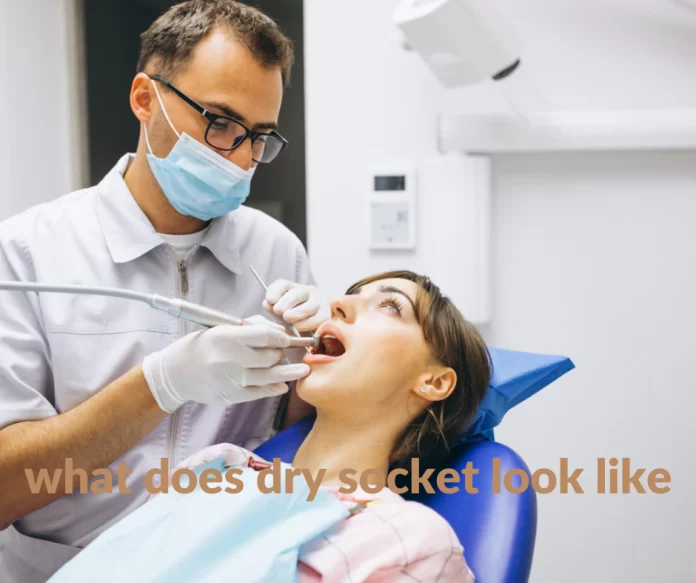Dry socket, medically known as alveolar osteitis, is a painful condition that can occur after tooth extraction. It is characterized by the inflammation of the bone in the empty tooth socket (alveolus) after a tooth has been removed. Dry socket can cause significant discomfort and delay the normal healing process.
Table of Contents
What Does Dry Socket Look Like?
Dry socket, also known as alveolar osteitis, is a condition that can occur after a tooth extraction, particularly a wisdom tooth removal. It is characterized by a specific set of symptoms and visual signs that indicate complications in the healing process. While it’s important to note that not all cases of tooth extraction result in dry socket, here’s an explanation of what dry socket looks like:
- Exposed Bone: One of the most distinct visual characteristics of dry socket is the exposure of the underlying bone in the socket where the tooth was removed. The blood clot that normally forms in the socket after extraction may become dislodged or dissolve prematurely, leaving the bone exposed.
- Empty Socket: In cases of dry socket, the socket may appear empty or partially empty, lacking the typical protective blood clot that forms after a tooth extraction. This absence of clotting material can lead to increased sensitivity and discomfort.
- Pain and Discomfort: Dry socket is often accompanied by severe pain that can radiate from the extraction site to the surrounding areas of the face and jaw. The pain is typically throbbing and can be exacerbated by eating, drinking, or even talking.
- Bad Breath and Odor: An unpleasant odor or bad breath can sometimes accompany dry socket due to the exposure of bone and the potential for bacterial growth in the empty socket.
- Delayed Healing: The healing process after a tooth extraction is delayed in cases of dry socket. Instead of the normal progression of tissue healing over the socket, the exposed bone and lack of proper clotting can hinder the formation of new tissue.
Causes and Risk Factors
Several causes and risk factors contribute to the development of dry socket:
- Blood Clot Dislodgement: The blood clot that forms in the socket plays a crucial role in protecting the underlying bone and promoting healing. If this clot is dislodged due to various reasons, the bone becomes exposed, leading to dry socket.
- Trauma during Extraction: Excessive trauma or force during the tooth extraction procedure can disrupt the formation of a stable blood clot. Rough handling of the tissue can increase the likelihood of clot dislodgement.
- Smoking and Suction: Smoking after a tooth extraction can be a significant risk factor. The act of smoking introduces suction and negative pressure in the mouth, which can disturb the blood clot and prevent proper healing.
- Poor Oral Hygiene: Inadequate oral hygiene practices can introduce bacteria into the socket, increasing the risk of infection and disturbing the clot. This can impede the healing process and contribute to dry socket.
- Hormonal Factors: Hormonal changes, such as those associated with the menstrual cycle, birth control use, or hormone replacement therapy, can influence the healing process and increase the risk of dry socket.
- Type of Extraction: Wisdom teeth extractions, especially lower wisdom teeth, are more prone to developing dry socket due to the complex anatomy and position of these teeth.
- Age and Gender: Dry socket is more common in individuals over the age of 30 and tends to occur more frequently in women.
- Previous History of Dry Socket: If an individual has experienced dry socket after a previous tooth extraction, they are at a higher risk of developing it again.
- Medical Conditions and Medications: Certain medical conditions and medications that affect blood clotting or healing, such as anticoagulant use or history of clotting disorders, can increase the risk of dry socket.
- Personal Habits: Certain personal habits, such as aggressive rinsing, drinking through straws, or consuming hard or crunchy foods shortly after extraction, can disrupt the blood clot and contribute to dry socket.
Recognizing the Signs of Dry Socket
- Intense Pain: One of the most prominent symptoms of dry socket is severe and worsening pain, typically beginning a few days after a tooth extraction. The pain is often described as throbbing and can radiate to the ear, eye, or neck on the same side as the extraction site.
- Empty Socket Appearance: Upon visual inspection, the socket may appear empty or partially empty. The blood clot that normally forms in the socket after extraction might be absent or dislodged, leaving the underlying bone exposed.
- Exposed Bone: If you notice a whitish or grayish appearance in the socket, it could indicate the exposed bone. The absence of the protective clot can lead to direct contact between the bone and the oral environment.
- Bad Breath and Unpleasant Taste: Dry socket can result in an unpleasant taste in the mouth and bad breath due to bacterial activity and debris accumulating in the socket.
- Delayed Healing: If the normal healing process is disrupted by dry socket, you might observe slower healing of the extraction site. Instead of seeing gradual tissue coverage, the socket might remain open.
- Pain Relief Not Achieved with Pain Medication: Pain associated with dry socket often doesn’t respond well to over-the-counter pain medications. If your pain persists despite taking pain relief medication, dry socket could be a possible cause.
- Increased Pain after a Few Days: While some discomfort is expected after a tooth extraction, if the pain suddenly worsens a few days after the procedure, it could be indicative of dry socket.
- Pain with Eating and Drinking: Chewing or drinking can exacerbate the pain if you have dry socket. The pressure applied to the socket during these activities can intensify the discomfort.
Preventive Measures
- Follow Post-Extraction Instructions: Pay close attention to the post-operative instructions provided by your dentist or oral surgeon. These guidelines are designed to promote proper healing and prevent complications.
- Avoid Smoking and Tobacco Products: Smoking is a major risk factor for dry socket. Refrain from smoking or using any tobacco products for at least a few days after the extraction. The suction created during smoking can disrupt the blood clot formation.
- Skip Straws: Avoid using straws for drinking during the initial days after the extraction. The sucking motion can dislodge the blood clot and impede healing.
- Maintain Good Oral Hygiene: Gently brush your teeth and tongue, but be cautious around the extraction site. Rinse your mouth with warm salt water as recommended by your dentist to keep the area clean.
- Be Gentle: Avoid vigorous rinsing or spitting for the first 24 hours after the extraction. Gentle and careful oral care can help protect the blood clot.
- Soft Diet: Stick to a soft diet for the first few days after the extraction. Avoid crunchy, hard, or sticky foods that could disturb the healing site.
- Hydration: Stay well-hydrated by drinking plenty of water. Hydration supports the healing process and overall oral health.
- Avoid Alcohol: Avoid consuming alcoholic beverages in the initial days after the extraction, as alcohol can interfere with the clotting process.
- Manage Hormonal Changes: If you’re undergoing any hormonal changes due to menstrual cycles, birth control, or hormone replacement therapy, discuss these factors with your dentist. Hormonal changes can influence healing.
- Notify Your Dentist: If you have a history of dry socket or other oral complications, inform your dentist or oral surgeon before the extraction. They can take additional precautions to minimize the risk.
Seeking Professional
- Contact Your Dentist or Oral Surgeon: As soon as you notice the signs of dry socket, reach out to your dentist or oral surgeon. Explain your symptoms and schedule an appointment for evaluation and treatment.
- Explain Your Situation: During your appointment, provide a detailed description of your symptoms and when they started. This information will help your dental professional make an accurate diagnosis.
- Physical Examination: Your dentist or oral surgeon will examine the extraction site to determine if dry socket is indeed the cause of your symptoms. They will look for visual signs such as an empty socket or exposed bone.
- Pain Relief: If dry socket is confirmed, your dental professional will provide immediate pain relief. This may involve cleaning the socket to remove debris and placing a medicated dressing to promote healing and alleviate discomfort.
- Instructions for Care: Your dentist or oral surgeon will give you specific instructions on how to care for the socket at home. This might include proper oral hygiene practices, dietary recommendations, and avoiding activities that could disrupt the healing process.
- Prescribed Medications: You might be prescribed pain medication or antibiotics to manage pain and prevent infection. Follow the prescribed regimen as directed.
- Follow-Up Appointments: Your dental professional will likely schedule follow-up appointments to monitor your progress and ensure that the dry socket is healing properly.
- Rest and Recovery: During the healing process, it’s important to rest and avoid strenuous activities that could put additional pressure on the extraction site.
Healing and Recovery
- Follow Professional Recommendations: Abide by the care instructions provided by your dentist or oral surgeon. Their guidance is tailored to your specific situation and is essential for effective healing.
- Rest and Take It Easy: Allow your body to rest and recover. Avoid strenuous activities and physical exertion that could potentially disrupt the healing process.
- Pain Management: Take any prescribed pain medications as directed by your dental professional. Over-the-counter pain relievers can also provide relief. However, avoid aspirin, as it can increase the risk of bleeding.
- Oral Hygiene: Gently clean your mouth, including the extraction site, using a soft-bristle toothbrush. Rinse with warm salt water as recommended by your dentist to promote cleanliness and minimize bacteria.
- Warm Compress: If you experience facial swelling, you can apply a warm compress to the outside of your face for short periods. Always wrap the compress in a cloth to avoid direct contact with your skin.
- Patience: Healing takes time. Be patient and allow your body to gradually recover. Avoid unnecessary stress or worry.
Conclusion:
Navigating the realm of dental health and post-extraction recovery brings us to the question: “What does dry socket look like?” While the appearance of dry socket may not be distinct, its presence is certainly marked by unmistakable signs and discomfort. These signs, including intense pain, foul breath, and exposed bone, serve as crucial indicators that prompt action and attention.
Understanding the significance of these symptoms is vital for anyone who has undergone tooth extraction. By promptly recognizing the signs and seeking professional dental care, you can effectively address the issue and prevent further complications. Prevention plays a significant role as well. Following your dentist’s post-extraction care instructions, avoiding activities like smoking that can increase the risk of dry socket, and maintaining impeccable oral hygiene all contribute to a smoother recovery process.
Furthermore, in the broader context of oral health and its impact on overall well-being, it’s important to recognize the interconnectedness of dental health with other health aspects, such as sexual health. For instance, medications like generic tadalafil, used for treating erectile dysfunction, can be influenced by one’s oral health status. In the UK, those interested in learning more about how their dental health might affect or be affected by such medications can click here for additional information and resources.
FAQ
Q1: How long does it take for a blood clot to form after a tooth extraction?
Ans: It can take up to 24-48 hours for a blood clot to form after a tooth extraction.
Q2: What causes dry sockets?
Ans: Dry socket is caused when the blood clot that forms after a tooth extraction becomes dislodged or dissolves, exposing the underlying bone and nerves.
Q3: Is dry socket common?
Ans: Dry socket is relatively uncommon, occurring in approximately 2-5% of all tooth extractions.
Q4: Can smoking increase the risk of dry socket?
Ans: Yes, smoking can increase the risk of dry socket by interfering with the healing process and reducing blood flow to the surgical site.
Q5: How is dry socket diagnosed?
Ans: Dry socket is diagnosed by a dentist or oral surgeon based on a patient’s symptoms and an examination of the surgical site.











![How to Unlock Bootloader without PC On Android [2022]](https://cracktech.net/wp-content/uploads/2019/02/unlock-boot.png)